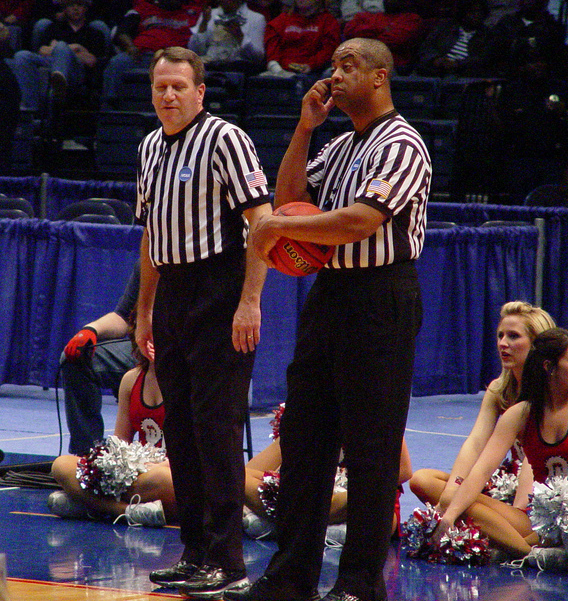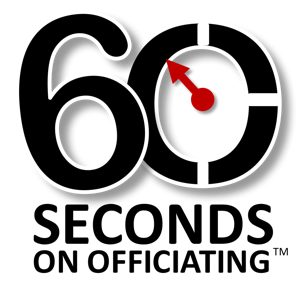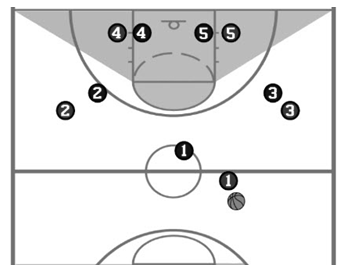
NCAA Referees Gary Maxwell, and Zelton Steed take a break during a TV Timeout in Birmingham. Photo courtesy of Garry Thompson.
Where to Spot the Ball
A key part of “getting the play right” is where the ball is spotted after the official makes their ruling on a violation, a non-shooting foul or resumes play at the completion of a timeout.
This often overlooked component of the game can lead to careless spot placements, which will undoubtedly create unfair advantages for
teams inbounding the ball.
Be vigilant in visualizing your “Inbound Triangle” for determining throw in spots for non-shooting fouls in the offensive team’s front court.
Did the foul occur inside your imaginary lines running from the free throw line elbows to the end line corners, or at the top of the key?
If so, the throw in spot will be on the endline.
If the foul took place outside the imaginary lines, then the spot throw in will take place on the sideline.
Careless ball placement, or a lack of understanding of the “Inbound triangle” will lead to several unfair advantages given (or missed opportunities for end line throw-ins) throughout the course of your game.
It is the location of the foul, not the location of where the ball is at the time of the foul that determines where the resumption of play throw in is to take place.
Conversely for timeouts, it is the location of the ball, not where the player or coach is who requests the stoppage in play that determines where the ball will be spotted to resume play.
The inconsistent spotting of throw-ins to resume play is common complaint of supervisors and those evaluating game tape. Be mindful of these throw in tips and you will be an “Image of Difference” official!


where is the ball inbounded if a spot throw-in is not touched by a player inbounds but rather is bounced off a “sideline” basket support hanging over the court?
Closest to that spot where the violation occurred … which could be under that overhanging basket.
Billy, wouldn’t this be a throw-in violation by the throwing team, and the ball would be awarded to the opposing team at the same spot where this throw-in occurred (similar to how you administer a throw-in violation where the throwing team throws the ball OOB without anyone touching it)?
After a common foul near the corner, but not in the imaginary lines, is the ball spotted out near the divisional line or to the side closest to where the foul occurred?
If a ball is deflected on an inbounds play on the left side of the basket by the defensive team, and the ball bounces out clear on the right side of the court without being touched again, is the placement at the last point of contact or where the ball went OOB?
after a timeout is called in backcourt, where does play resume?
Question on possession arrow.
Team A has possession arrow to start the 2nd quarter. Team has fails to put the ball in play ( 5 second count). Team B now has possession to put the ball in play. Team B successfully put the ball in play, does the possession arrow switch to Team B.
A violation on the inbounding team causes them to lose the ball and arrow. If there is a foul that occurs on an Alt possession inbounds then they do not lose the arrow. Fouls do not change it for either team…violations on the offense do.. 5 seconds, step on the line, etc
What if the official blows the play dead to fix a time error and the ball was at a completely different spot at the time of the error?
If a ball goes out of bounds on the sideline corner does the throw in take place where the ball went out or is there a designated sideline area for throw ins more towards center court?
If it goes out on the sideline side of the corner, it comes in on the corner of the sideline, not on the endline. This is the same for NFHS and NCAA-M rules (NCAA-W rules on inbound spots are the same as NFHS).
Offensive team player throws the ball out of bounds to the sideline. Opposing coach then calls time out. Referee after the time out says the ball is being placed at or about half court other coach complains and they move the inbound play farther down the side line. Is that correct or should the ball be inbounded from where the referee originally says it eas going to be placed.
A shot is missed and the ball bounds up and over the top of the backboard. The referee then requires that the inbound pass be made from the sideline. Why the sideline? Why not from the endline?
If there is a reaching foul where abouts on the court do I give the ball to the imbounder
In regards to the article, it makes no difference whether the throw in is in front court
or back court, or which direction the ball will be going, the throw in is the same as the diagram shows.